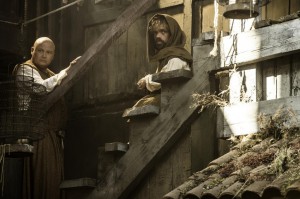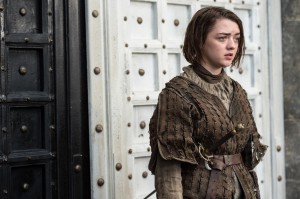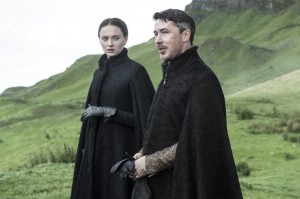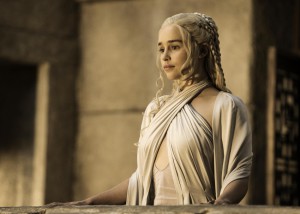Game of Thrones: Adaptation and Fidelity in an Age of Convergence
Post by Iain Robert Smith, Senior Lecturer in Film Studies, Department of Media, Culture and Language, University of Roehampton
This is the fourth installment in the ongoing “From Nottingham and Beyond” series, with contributions from faculty and alumni of the University of Nottingham’s Department of Culture, Film and Media. This week’s contributor, Iain Robert Smith, completed his PhD in the department in 2011.
 On Sunday, April 12th, the fifth season of Game of Thrones will premiere simultaneously in more than 170 countries and territories. [1] A truly transnational production with filming taking place this season in Northern Ireland, Croatia and Spain, Game of Thrones is both the most watched show in HBO’s history and the world’s most-pirated TV show. Adapting George R.R. Martin’s series of epic fantasy novels, A Song of Ice and Fire (1996-), showrunners David Benioff and Dan Weiss have managed, on the whole, to satisfy both fans of the books and audiences unfamiliar with Martin’s works. Yet this season marks a significant shift in the adaptation process, one that has the potential to challenge many traditional notions of fidelity criticism. Despite starting to write the first volume in 1991, George R.R. Martin is still in the process of writing the book series, and this season looks to be the transitional moment when the show will start to overtake the books. In this short article, therefore, I would like to consider what happens to fidelity criticism when a show goes beyond the published material and starts to “adapt” material that has been planned but not yet written by the original author.
On Sunday, April 12th, the fifth season of Game of Thrones will premiere simultaneously in more than 170 countries and territories. [1] A truly transnational production with filming taking place this season in Northern Ireland, Croatia and Spain, Game of Thrones is both the most watched show in HBO’s history and the world’s most-pirated TV show. Adapting George R.R. Martin’s series of epic fantasy novels, A Song of Ice and Fire (1996-), showrunners David Benioff and Dan Weiss have managed, on the whole, to satisfy both fans of the books and audiences unfamiliar with Martin’s works. Yet this season marks a significant shift in the adaptation process, one that has the potential to challenge many traditional notions of fidelity criticism. Despite starting to write the first volume in 1991, George R.R. Martin is still in the process of writing the book series, and this season looks to be the transitional moment when the show will start to overtake the books. In this short article, therefore, I would like to consider what happens to fidelity criticism when a show goes beyond the published material and starts to “adapt” material that has been planned but not yet written by the original author.
In the fifteen years since Robert Stam published his influential critique of fidelity criticism, “Beyond Fidelity: The Dialogics of Adaptation,” the academic study of adaptation has attempted to move away from discourses of fidelity that privilege the “original” source above the adaptation, to embrace instead an alternative intertextual model of “texts generating other texts in an endless process of recycling, transformation and transmutation, with no clear point of origin.” While there have been some attempts to reclaim and rehabilitate fidelity criticism (e.g. MacCabe et al, True to the Spirit, 2012), there is still a prevailing assumption that notions of fidelity reinforce a problematic hierarchy between source and adaptation, where the novel is valued above its screen adaptation. Yet, as Christine Geraghty has noted, while we may wish to move beyond fidelity criticism in our own textual analysis, the question of faithfulness is nevertheless still important in studies of reception, given that “faithfulness matters if it matters to the viewer.”

As we might expect, the fandom surrounding Game of Thrones is heavily invested in issues of faithfulness, although it should be noted that the forums primarily devoted to the TV show, such as Winter is Coming and Watchers on the Wall, tend to be more open to changes than those that predated the show, such as A Forum of Ice and Fire. One of the difficulties of this particular adaptation was that George R.R. Martin had deliberately conceived of the book series as something that would only be achievable in the literary form. After having worked for ten years in Hollywood as a writer and producer on shows such as The Twilight Zone (1985-1989) and Beauty and the Beast (1987-1990), Martin made the conscious decision to return to prose fiction to escape the restrictions of a TV budget and shooting schedule. In this age of media convergence, serialized television may be becoming more novelistic in its form, yet it is nevertheless still the case that there are significant differences in what each medium can achieve. Certainly, by constructing an epic fantasy world with over a thousand named characters, 31 of whom are given their own point-of-view chapters, Martin’s book series posed a serious challenge for anyone who wished to adapt it to the screen.
Most of the changes made by the showrunners to date have been relatively small, such as amalgamating some minor characters, cutting out much of the historical background, aging up the central protagonists, and adding extra scenes to provide insight into characters — such as Tywin Lannister, Margaery Tyrell and Robb Stark — who were never given a POV chapter in the novels. The upcoming season, on the other hand, looks to be making substantial changes. While the showrunners found two seasons’ worth of material to adapt from the plot-heavy third book (A Storm of Swords), they have elected to adapt the slower-paced fourth (A Feast for Crows) and fifth (A Dance with Dragons) books together in a single season, with entire storylines dropped and others moving in a markedly different direction from their book counterparts. Furthermore, as some characters are progressing more quickly through their book material than others, it is looking likely that this season will introduce elements from the sixth book (The Winds of Winter), even though Martin is still writing it.
This has become a point of concern for many fans, and while there is some debate as to whether the sixth book will be published ahead of season six in 2016, it is clear that the series will conclude well before Martin publishes the planned seventh and final novel, A Dream of Spring. In 2013, the showrunners held a weeklong meeting in Santa Fe with Martin to discuss in detail his plans for the overall structure of the story, and it is evident that seasons six and seven of the show will be adapting these plans for the books that have not yet been written. [2]
This form of concurrent production has a number of implications for the debates surrounding the faithfulness of the Game of Thrones series to the books. Most importantly, the distinction between the book series as the “original” source text and the TV show as the “adaptation” becomes increasingly difficult to sustain. With the show overtaking the book series, television will not only be the first medium through which the majority of fans will discover the events of the final novel, but it will also have been written, shot and screened well before Martin finishes writing the novel. To a certain extent, this final novel therefore has the potential to be received by some fans more like a novelization that adapts the events of the TV series than as the “original” source. Of course, Martin’s status as the creator of the book series [3] means that A Dream of Spring will be treated as more than a “mere” novelization, but nevertheless we are confronted here with an increasingly blurred distinction between original and copy.
 Moreover, the anxieties surrounding spoilers will shift focus. Until now, the concern has been about book readers potentially spoiling events for show watchers, but it will now be show watchers who will be first to find out what happens. In an age of social media, it will be challenging for any readers who wish to avoid the show revelations and remain “unsullied” until the novels’ release. Indeed, this process has already begun, with any changes made by the showrunners provoking fevered speculation on forums about what this may mean for the future books. The choice to remove certain storylines and characters from the show is treated as an inadvertent spoiler, alerting viewers that these story arcs will turn out to be relatively insignificant within the future novels.
Moreover, the anxieties surrounding spoilers will shift focus. Until now, the concern has been about book readers potentially spoiling events for show watchers, but it will now be show watchers who will be first to find out what happens. In an age of social media, it will be challenging for any readers who wish to avoid the show revelations and remain “unsullied” until the novels’ release. Indeed, this process has already begun, with any changes made by the showrunners provoking fevered speculation on forums about what this may mean for the future books. The choice to remove certain storylines and characters from the show is treated as an inadvertent spoiler, alerting viewers that these story arcs will turn out to be relatively insignificant within the future novels.
Of course, the fact that both the novels and show are still in process means that this dynamic may change over time. Martin’s original outline for the book series was recently revealed, showing that he had initially intended for the series to be a trilogy with a markedly different structure and focus. Within that letter to his publisher, he admits that, “As you know, I don’t outline my novels. I find that if I know exactly where a book is going, I lose all interest in writing it.” We may find therefore that the book series will ultimately diverge from the outlines planned by Martin alongside the showrunners in 2013. It is telling that in a recent interview with Entertainment Weekly, Martin teased that he has recently come up with a shocking new twist to the novels that they can’t do on the show because they have “made a couple [of] decisions that will preclude it.” The showrunners may face pressure from the fans to stay relatively faithful to the plans for the novels, but as the storylines start to diverge, Martin seems less concerned with restricting himself to staying faithful to those earlier plans. We are moving to a situation in which we have two parallel adaptations, both based on but not beholden to those outlines laid out in that weeklong meeting in Santa Fe. Notions of fidelity may still play a role in the reception of Game of Thrones, yet it is not so clear what the “original” text is to which the showrunners are being asked to be faithful.
 To conclude, therefore, I’d like to put forward a few questions that this case study raises: 1) To what extent do notions of faithfulness still matter when the source itself is under development? 2) How will fans respond to differences between the ending of the show and the ending of the novels, especially if they experience the show first? 3) How are our ideas of the “original” and the “copy” challenged in these rare cases of concurrent production? While this has only been a short mapping out of these issues ahead of the premiere on Sunday, I hope that future scholarship explores the wider implications that this fascinating case study may have for issues of fidelity criticism and adaptation in an age of convergence.
To conclude, therefore, I’d like to put forward a few questions that this case study raises: 1) To what extent do notions of faithfulness still matter when the source itself is under development? 2) How will fans respond to differences between the ending of the show and the ending of the novels, especially if they experience the show first? 3) How are our ideas of the “original” and the “copy” challenged in these rare cases of concurrent production? While this has only been a short mapping out of these issues ahead of the premiere on Sunday, I hope that future scholarship explores the wider implications that this fascinating case study may have for issues of fidelity criticism and adaptation in an age of convergence.
Notes
[1] Although unfortunately not here in the UK, where Sky Atlantic has elected to premiere the episode on Monday evening instead.
[2] This situation is reminiscent of the collaboration between Arthur C. Clarke and Stanley Kubrick on 2001: A Space Odyssey (1968), where they collaborated on the screenplay together, then went off to work on their respective novel and film concurrently. Both deviated from the early drafts of the screenplay, and the resultant works contained many similar elements but were substantially different in tone and content.
[3] Martin’s active involvement with the TV production, having written an episode each for seasons one to four, further complicates this dynamic.


